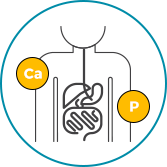Vitamin D
Important information about vitamin D
Vitamin D is understood as a group of steroidal organic chemical compounds: vitamin D1 (calciferol), vitamin D2 (ergocalciferol) and vitamin D3 (cholecalciferol). These are fat-soluble vitamins. It means that they are not excreted from the body with urine or sweat, but are stored in the fatty tissue and the liver.1,6
Sources and absorption of vitamin D
From the human nutrition point of view, vitamins D2 and D3 play the most important role. In the human body, these vitamins can be formed under the influence of sunlight (vitamin D3) or can be supplied with food (vitamins D2 and D3).
There are only a few natural sources of vitamin D:1,3,6-8
- ergocalciferol (vitamin D2) occurring naturally in plant tissues – yeasts, cap mushrooms,
- cholecalciferol (vitamin D3) occurring naturally in animal organisms; it is most easily obtained from fatty fish meat (salmon, cod, tuna, herring, mackerel, sardines), fish oils, animal products (beef liver, egg yolks).
The absorption of vitamin D from food sources depends on many factors. Laxatives and corticosteroids reduce its absorption.22
Vitamin D units
1 Вµg cholecalciferol = 40 IU vitamin D
1 IU vitamin D = 0.025 Вµg cholecalciferol








